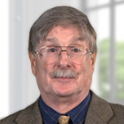Playlist
Show Playlist
Hide Playlist
Cell Cycle: RB Locks the Cycle
-
Slides CP Neoplasia Cell Cycle.pdf
-
Reference List Pathology.pdf
-
Download Lecture Overview
00:01 Let's go back to the retinoblastoma genes. Let's talk a little bit more about that. 00:05 And remember it's going to be an important way that we regulate the go, no, go signal at the G1S phase. 00:12 Okay, so normally retinoblastoma gene product that the RB protein is not highly phosphorylated. 00:23 It may have a couple phosphate groups on it, but it's not highly phosphorylated and in that particular confirmation it binds to elongation factor 2, E2F, and holds it there and it's kind of like a lock on the cell cycle. 00:35 See the motorcyclist, it's a cycle and he's got a little lock on the wheel so that it can't go around. 00:42 That's what the hypophosphorylated RB protein is doing. It's not allowing the cycle to progress. 00:49 And it does so because it has the E2F and the hypophosphorylated RB protein sit down on the E2F sites, things that are going to be transcribed and brings in also histone deacetylase and histone methyltransferases that are going to turn off transcription at that site. So that's basically how it's a big lock on the site. 01:14 Okay. It allows E2F to bind to its transcription site, but it turns off active transcription by binding so avidly. Cool. 01:25 Alright. How do we release the cell cycle? How do we take the lock off the cycle? Okay. This is where - now, we have growth factors that have come in. 01:35 We have gone through the early stages of G1 and we're at the kind of G1S site on a cell cycle. 01:43 As we gone through the growth cycle, the early growth G1 phase we are generating cyclin D and cyclin E. 01:55 And the cyclin D is going to interact to CDK4, also CDK6. 01:59 Cyclin D is going to interact with CDK2 and they are going to, as part of their activity, remember when you have the cyclin bind to a CDK, it becomes an active kinase. 02:12 Those active kinases and those complexes now are going to hyperphosphorylate at many, many, many more phosphate groups to retinoblastoma. 02:22 When it does so, that protein now releases E2F. 02:28 So, you can see that hyperphosphorylated thing and now the E2F is free to go about its business, elongation factor 2. 02:36 Now, it can sit down on its site and we no longer have the histone methyltransferases so the histone deacetylases and we get active transcription of the next set of proteins. Okay? So, we have gotten the signal that allows us to progress through the cell cycle through the G1S checkpoint. 02:56 There are various ways that we can also stimulate the next steps or inactivate the next steps. 03:04 And as part of the control regulatory pathways, you can elaborate inhibitors that block that hyperphosphorylation step. 03:13 Okay, so it can be bewildering, but when we do have the E2F free to do its thing away from RB, the cell cycle lock is gone. 03:23 And now you see our motorcycle is speeding away. 03:26 So, in words, sometimes words are easier to understand. 03:32 Retinoblastoma is a protein that is a break from the cell cycle. 03:38 In its hypophosphorylated state, it complexes with E2F a transcription factor complex as well as histone deacetylase and histone methyltransferase to keep downstream cell cycle genes turned off. 03:53 When we get the elaboration of cyclin D and then the complex of cyclin D plus CDK, that will phosphorylate RB and other proteins as well, but that phosphorylation to the RB dissociates it from the histone deacetylase and removes inhibition of E2F and now we can get elongation of the new genetic material will enter the S phase. 04:19 Other cyclins and other DNA polymerases are also expressed and this will push us ultimately through the G1S transition, but the key feature is the release of E2F from the RB break. 04:34 So, now we're off and running on that cell cycle.
About the Lecture
The lecture Cell Cycle: RB Locks the Cycle by Richard Mitchell, MD, PhD is from the course Neoplasia.
Included Quiz Questions
Which cyclin assists in the phosphorylation of the RB protein?
- Cyclin D
- Cyclin A
- Cyclin B
- Cyclin 2
- Cyclin 1
What does RB protein complex with in a hypophosphorylated state?
- E2F
- Cyclin D
- Cyclin E
- Cyclin D/CDK4
- Cyclin E/CDK2
Customer reviews
5,0 of 5 stars
| 5 Stars |
|
5 |
| 4 Stars |
|
0 |
| 3 Stars |
|
0 |
| 2 Stars |
|
0 |
| 1 Star |
|
0 |




